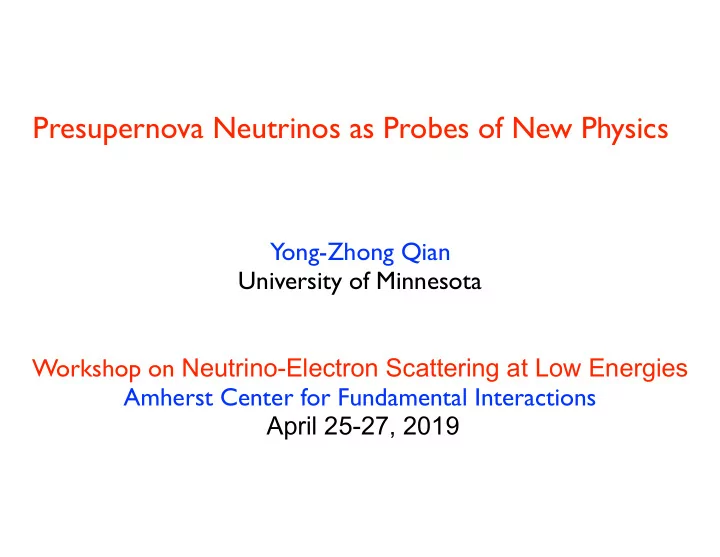

Presupernova Neutrinos as Probes of New Physics Yong-Zhong Qian University of Minnesota Workshop on Neutrino-Electron Scattering at Low Energies Amherst Center for Fundamental Interactions April 25-27, 2019
Summary Neutrino cooling is the standard energy loss mechanism governing evolution of massive stars Presupernova neutrinos provide advance warning for nearby supernovae within ~1 day JUNO might be able to distinguish the neutrino mass ordering through detection of presupernova neutrinos Dark photons complicate stellar evolution but might be constrained by detection of presupernova neutrinos
How to Become a Star Virial theorem for a contracting gas cloud ~ 2 2 m e d 2 ∼ GMm p T c + R ✓ M ◆ d 3 ∼ R 3 ⇒ m p ✓ M ◆ 2 / 3 1 − ~ 2 T c ∼ GMm p R 2 R 2 m e m p ⇒ T c, max ∝ M 4 / 3
<latexit sha1_base64="gO5SvmwOY4cXmYhtz3PNM0OLkI=">ACZHicdVFNTxsxFPRuy0cDpUtRT5UqiwiphyqsE1TCDZUDXCJRApm6y8jexsNeu7W0VWfsne+uRC78DLxvUD5UnWRrNjN/zG2eKM2Pj+FcQvni5srq2/q1sfl6020/fbKyFITOiS32TYUM5K+jQMsvpjdIUi4zT6+z2pNav1NtmCwu7ULRscCzguWMYOupNHJ7Sa4xcZcpmRxULtFzmZJ9kaoqMUzARjwd1IS7qD4l30o8hY2rNjT6wGuTXtVKLthsbrHW8gf83b31LZKlJbKSjiYOLTfrdKoHXfiOEYIwRqgw8+xB0dH/S7qQ1RLvtpgWedp9DOZSlIKWljCsTEjFCs7dlhbRj180tDFSa3eEZHhZYUDN2jyFVcM8zU5hL7U9h4SP75w2HhTELkXmnwHZu/tVq8n/aqLR5f+xYoUpLC9IMyksO/aJ14nDKNCWLzARDP/Vkjm2Kdj/b+0fAhPm8LnwVW3g3qd7teD9vGXZRzr4D3YBR8BAofgGJyBczAEBNwFa0EUbAf34Wa4E75rGwvLMD/qrwMBhrmB</latexit> <latexit sha1_base64="CfyU2asf/dn98lOw8Hhq6Sfsz9M=">ACXHicdVFBT9swGHUytpUCWzekXaxViFxmEqSRpTd0HbYLkiAKCA1beS4Tmthx579ZVMV5U9y47K/sjmkSDBtn2Tp6b3fZ/9nGnBLQTBnec/23j+4mVns7u1vfPqde/N20urSkPZmCqhzHVGLBO8YGPgINi1NozITLCr7OZLo1/9YMZyVzASrOpJIuC5wScFTas3tJbgitLlI6i+sqMUuV0gOZ6jqxXOJW/HrSENV5/TH5XpI5bl2NodVPnDYb1t3knC+WQIxRP7EbmGijNKi1Z1aFB1HdTEl7/WDw6egwig9xMAiCURiFDYhG8TDGoWOa6qN1na92SuaClZAVQaydhoGFaEQOcCub2lpZpQm/Igk0cLIhkdlrdh1PjPcfMca6MOwXge/ZxR0WktSuZOacksLR/aw35L21SQn40rXihS2AFbRflpcCgcJM0nPDKIiVA4Qa7u6K6ZK4LMD9R9eF8PBS/H9wGQ3C4SA6i/vHn9dxdNB79AHtoxCN0DH6hk7RGF0h357HW/T+Vv+Fv+Tmv1vXPLnpS/rs/cYK3dg=</latexit> <latexit sha1_base64="3lG5nCaEJQ7Rc2Qv58r7S05Mw=">ACZXicdVFNbxMxFPQuXyFQSAviwgGLqFKRULpOKpoekCo4wKVSQU1bKU5XsebWLXxn6LFC37J7lx5cLfwNtNxYfgSZGM/Oe/caZVdJDknyL4hs3b92+07nbvXd/48HD3ubWqTel42LCjTLuPGNeKFmICUhQ4tw6wXSmxFl2+bRz4L56UpTmBlxUyzRSFzyRkEKu19obljvDpJ+cVeXVG3NCnf1amtqZcat+K7o4aoPtYv6aeSzXHragytfhS0i1Hd3X4dxlAlctj5NXV0PbWmTi6W8IJaZywYHMS0108GSZIQnADyP6rJICDg/GQjDFpFB9tK7jtPeVzg0vtSiAK+b9lCQWZhVzILkSdZeWXljGL9lCTAMsmBZ+Vl2lVOPtwMxblw4BeAr9veOimnvVzoLTs1g6f/WGvJf2rSEfDyrZGFLEAVvL8pLhcOSTeR4Lp3goFYBMO5keCvmSxYCgvAx3RDC9ab4/+B0OCjwfDXv/wzTqODnqKnqMdRNA+OkTv0TGaI6+R51oM9qKfsQb8eP4SWuNo3XPI/RHxc9+AuzIuew=</latexit> Massive stars are radiation dominated ! T 4 ∼ GMm p ρ c ∼ M c , ρ c /m p R R 3 ⇒ T c ∝ M 1 / 2 R ⇒ T 3 c ∝ M 1 / 2 ρ c
Janka 2012
25 M Presupernova Star � 900 R � 1 R � H, He He Si, S, Ar, Ca O, Mg, Ne Fe He, C 0.1 R � 0.01 R �
T c ∝ ρ 1 / 3 c Woosley, Heger, Weaver 2002
Nuclear burning stages (20 M Ꙩ stars) Fuel Main T Time Secondary Main Product Reaction Product (10 9 K) (yr) H He 14 N 0.02 10 7 CNO 4 H 4 He He O, C 18 O, 22 Ne 0.2 10 6 3 He 4 12 C 12 C ) 16 O s-process C Na 0.8 10 3 Ne, 12 C + 12 C Mg Ne O, Mg Al, P 1.5 3 20 Ne ) 16 O 20 Ne ) 24 Mg O Si, S Cl, Ar, 2.0 0.8 16 O + 16 O K, Ca Si,S Fe Ti, V, Cr, 3.5 0.02 28 Si )… Mn, Co, Ni
来自大质量恒星和伽玛射线暴的中微子 并产生大量 � �� � 在主序星中,氢的燃烧过程主要通过两种方式进行, �� 链式反应( �� ����� )和 阳中微子有所区别。 的流量将与太 ,不过由于温度与密度的不同,各过程中 会以相同的方式产生 它们归为独立的一类来作介绍。与太阳一样,大质量恒星处于主星序阶段时,也 化理论。由于人们对太阳中微子更加了解,且基于太阳中微子的重要性,我们将 过对太阳中微子的探测,人们可以更好的检验太阳模型以及相关的恒星结构和演 通 。 主要通过将氢燃烧成氦从而释放能量, 上海交通大学博士学位论文 太阳处于主星序阶段时, ������ 中微子 文中,我们将对此作简要的阐述。 生成。表 ��� 中列举了恒星不同演化阶段中微子的亮度、产生方式以及味道组分。在下 由于恒星温度比较高,各种基本粒子和核素的大量存在,中微子可以通过很多反应通道 。 际物理系统中,大多数中微子的生成反应也涉及到电磁相互作用和强相互作用(核力) 中微子只参与弱相互作用,因此它的产生过程必定与弱相互作用直接相关;在实 表 ��� 中的数值在数量级上吻合。 ��� ��� ������ ��������������� ���� �� ������� ����� ���� � 图 ��� 大质量恒星中能量产生和损失速率 ���� 。 Energy Generation vs. Loss
Processes of Thermal Neutrino Emission Pair annihilation e − + e + → ν + ¯ ν Plasmon decay γ pl → ν + ¯ ν Photo-neutrino emission γ + e − → e − + ν + ¯ ν Bremsstrahlung ( Z, A ) + e − → ( Z, A ) + e − + ν + ¯ ν
上海交通大学博士学位论文 合公式在天体物理学和恒星演化中被广泛应用。为了讨论的方便,下文将比较我们的数 图 ���� 在 上中各不同热过程中微子能损速率的主导区域。在各区域中,该热过程对总中 微子能损的贡献超过 ��� 。图中,我们直接通过 ���� 拟合公式得到重组过程的能损速率。 ��� ���� ������� �� ����� ���� ��������� ��������� ��� �������� ������ ���� ����� �� ���� ������� ��� ���������� ������� ����������� ���� ���� ���� ���� ��� �� ��� ����� ����� ��� ������������� �������� ����� ��� �������� ���� ������ �� ��������� 图 ��� 给出了不同温度和密度下中微子能损速率的计算结果与 ���� 拟合公式的比 较。需要特别强调的是, ���� 等人关于各过程的拟合公式只在该过程占中重要地位时才 准确,不难发现,当考虑所有热过程的贡献时,我们中微子能损总速率与 ���� 等人的拟 � �� � 值结果与 ���� 拟合公式之间的差别。 这些拟 第二章 并得到了各过程的拟合公式 ���� 。 细致计算过上述这些热过程的中微子能损速率, 能量损失速率与前人的计算结果,从而检验我们计算结果的正确性。 ���� 及其合作者曾 们即可得到各热过程中微子的能损速率。在本小节中,我们先来比较我们得到的中微子 此人们主要侧重于计算中微子能损速率。对前文中得到的中微子能谱作简单的积分,我 因 由于中微子冷却对恒星 � 包括白矮星和中子星等 � 的演化十分重要, 前文已提到, 中微子能损速率和各热过程的主导区域 ������� 结果分析与讨论 ����� 来自大质量恒星的中微子 10.5 Guo & Qian 2016 10 Fe Pair Si 9.5 O = 1 20M Γ Log[T/K] 9 C Plasma 8.5 0 Photo 1 = Γ T F 8 3 . 0 = T Recom Brem 7.5 7 1 2 3 4 5 6 7 8 9 10 11 -3 Log[( / )/(g cm )] ρ µ e
<latexit sha1_base64="0prUyzNXOt9r7COKklwoaInUxY=">AB/XicdVDLSgNBEJz1GeMrPm5eBoMgBMLuJiTxFvTiMYJ5QDaG2UknGTI7u8zMCjEf8WLB0W8+h/e/BtnkwgqWtBQVHXT3eVHnClt2x/W0vLK6tp6aiO9ubW9s5vZ2+oMJYU6jTkoWz5RAFnAuqaQ6tSAIJfA5Nf3SR+M1bkIqF4lqPI+gEZCBYn1GijdTNHo+kZ6Iu5CLPB1ikYObXDeTtfNnlZJbLGE7b9tlx3US4paLhSJ2jJIgixaodTPvXi+kcQBCU06Uajt2pDsTIjWjHKZpL1YQEToiA2gbKkgAqjOZXT/FJ0bp4X4oTQmNZ+r3iQkJlBoHvukMiB6q314i/uW1Y92vdCZMRLEGQeL+jH5s0kCtxjEqjmY0MIlczciumQSEK1CSxtQvj6FP9PGm7eKeTdq2K2er6I4WO0DE6RQ4qoyq6RDVURxTdoQf0hJ6te+vRerFe561L1mLmAP2A9fYJzKCUzg=</latexit> What Can Pre-Supernova Neutrinos Tell Us ? Advance warning of supernovae Last-day events of 1 to 4 MeV for 1 kpc & 20 kton (JUNO) ν e + p → n + e + ¯ 12 M sun 15 M sun 20 M sun 25 M sun 6.1 11.9 20.2 24.2 1.8 3.5 5.9 7.1 Probe of neutrino mass ordering: NH/IH ~ 3.4 Test of stellar models: progenitor mass
Three Neutrino Mixing X X | ν α i = α i | ν i i , | ν i i = U α i | ν α i U ∗ i α s 13 e − i δ c 12 c 13 s 12 c 13 − s 12 c 23 − c 12 s 23 s 13 e i δ c 12 c 23 − s 12 s 23 s 13 e i δ U = s 23 c 13 s 12 s 23 − c 12 c 23 s 13 e i δ − c 12 s 23 − s 12 c 23 s 13 e i δ c 23 c 13
Neutrino Mixing in Vacuum U α i = h ν α | ν i i , ¯ U α i = h ¯ ν α | ¯ ν i i Neutrino Flavor Evolution in Matter (MSW only) normal mass hierarchy inverted mass hierarchy ν e /N 0 ν e /N 0 N ¯ ν e ≈ 0 . 76 N ¯ ν e ≈ 0 . 21 ¯ ¯
Guo, Qian, & Heger 2019 18 12, NH 16 15, NH 20, NH 25, NH 14 Reactor- ν Geo- ν 12 Events/MeV 10 Last-day Pre-SN 8 neutrinos 6 at JUNO for stars 4 at 1 kpc 2 1.5 2 2.5 3 3.5 4 4.5 5 5.5 6 E (MeV) ν
Recommend
More recommend